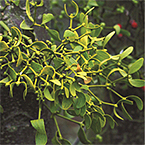European Mistletoe

On this page:
Introduction
This fact sheet provides basic information about European mistletoe—common names, what the science says, potential side effects and cautions, and resources for more information.
European mistletoe is a semiparasitic plant that grows on several types of trees in temperate regions worldwide. Where the term “mistletoe” is used in this fact sheet, it refers to European mistletoe. (European mistletoe is different from American mistletoe, which is used as a holiday decoration.) Mistletoe has been used for centuries in traditional medicine to treat seizures, headaches, and other conditions. Today, mistletoe is used mainly in Europe as a treatment for cancer.
The leafy shoots and berries of mistletoe are used to make extracts that can be taken by mouth. In Europe, mistletoe extracts are prescription drugs that are given by injection. In the United States, mistletoe by injection is available only in clinical trials.
What the Science Says
- Laboratory studies have found that mistletoe kills cancer cells and stimulates the immune system.
- The use of mistletoe to treat cancer has been studied in Europe in more than 30 clinical trials. Although improvements in survival or quality of life have been reported, almost all of the trials had major weaknesses in their design that raise doubts about the findings. For example, many of the studies had a small number of participants or did not have a control group.
Side Effects and Cautions
- Raw, unprocessed mistletoe is poisonous. Eating raw, unprocessed European mistletoe or American mistletoe can cause vomiting, seizures, a slowing of the heart rate, and even death. American mistletoe is unsafe for medicinal use.
- In countries where commercial mistletoe is available by injection, such as Germany, those extracts are considered to be generally safe when used according to product directions and under the supervision of a health care provider.
- Injected mistletoe extract may cause itching or redness in the area of the injection. Less commonly, side effects may include more extensive skin reactions, low-grade fevers, or flu-like symptoms. There have been very rare reports of more serious allergic reactions, such as difficulty breathing.
- Because mistletoe has not yet been proven to be a safe and effective cancer treatment, it should not be used outside of clinical trials.
- Tell all your health care providers about any complementary health practices you use. Give them a full picture of what you do to manage your health. This will help ensure coordinated and safe care. For tips about talking with your health care providers about complementary and alternative medicine, see NCCAM's Time to Talk campaign.
Sources
- American mistletoe. Natural Medicines Comprehensive Database Web site. Accessed at www.naturaldatabase.com on July 7, 2009.
- European mistletoe. Natural Medicines Comprehensive Database Web site. Accessed at www.naturaldatabase.com on July 7, 2009.
- Horneber M, Bueschel G, Huber R, et al. Mistletoe therapy in oncology. Cochrane Database of Systematic Reviews. 2008;(2):CD003297.
- Mistletoe (Viscum album L.). Natural Standard Database Web site. Accessed at www.naturalstandard.com on July 8, 2009.
- National Cancer Institute. Mistletoe Extracts (PDQ). National Cancer Institute Web site. Accessed at www.cancer.gov/cancerinfo/pdq/cam/mistletoe on June 3, 2010.
For More Information
NCCAM Clearinghouse
The NCCAM Clearinghouse provides information on NCCAM and complementary health approaches, including publications and searches of Federal databases of scientific and medical literature. The Clearinghouse does not provide medical advice, treatment recommendations, or referrals to practitioners.
PubMed®
A service of the National Library of Medicine (NLM), PubMed® contains publication information and (in most cases) brief summaries of articles from scientific and medical journals.
Office of Dietary Supplements (ODS), National Institutes of Health (NIH)
ODS seeks to strengthen knowledge and understanding of dietary supplements by evaluating scientific information, supporting research, sharing research results, and educating the public. Its resources include publications (such as Dietary Supplements: What You Need to Know), fact sheets on a variety of specific supplement ingredients and products (such as vitamin D and multivitamin/mineral supplements), and the PubMed® Dietary Supplement Subset.
This publication is not copyrighted and is in the public domain. Duplication is encouraged.
* Note: PDF files require a viewer such as the free Adobe Reader.
